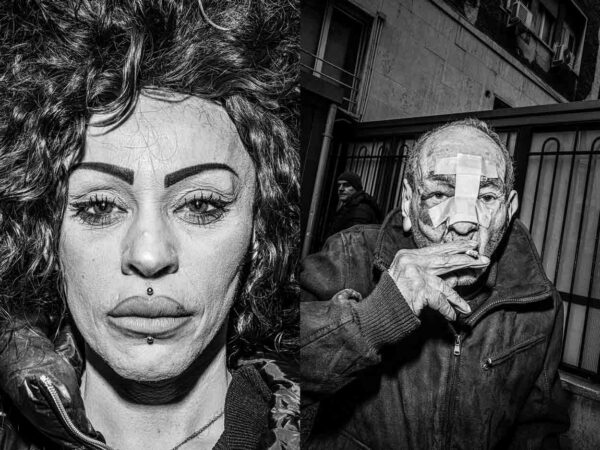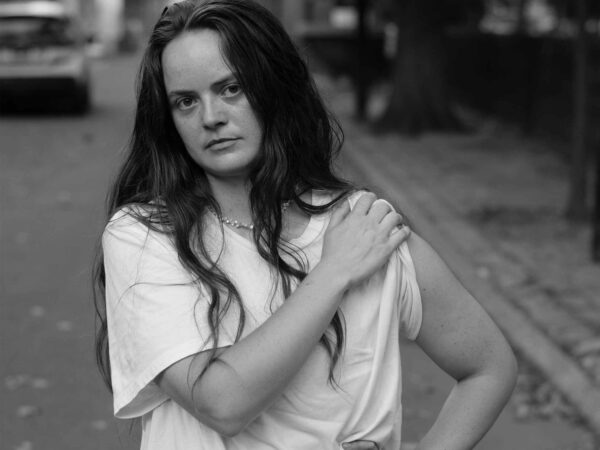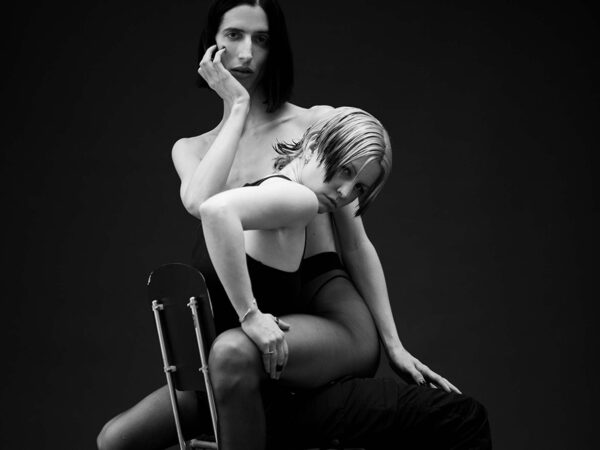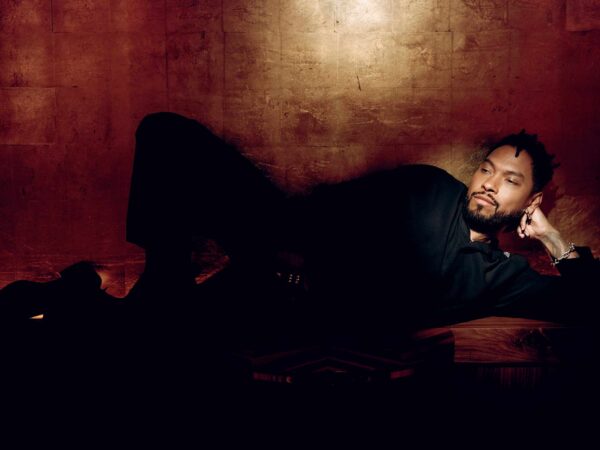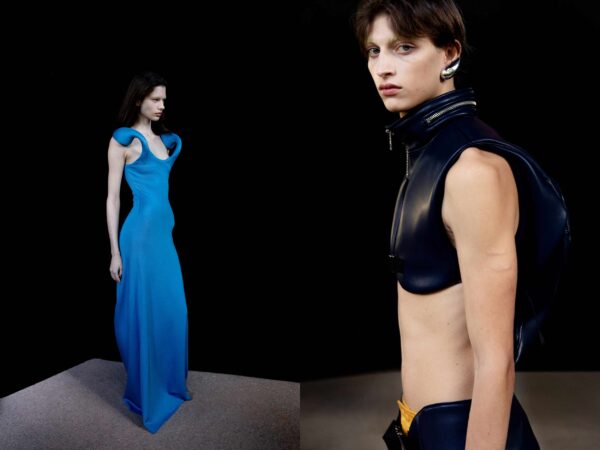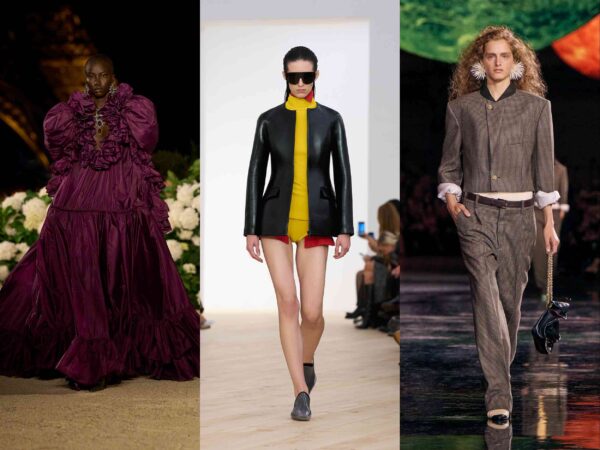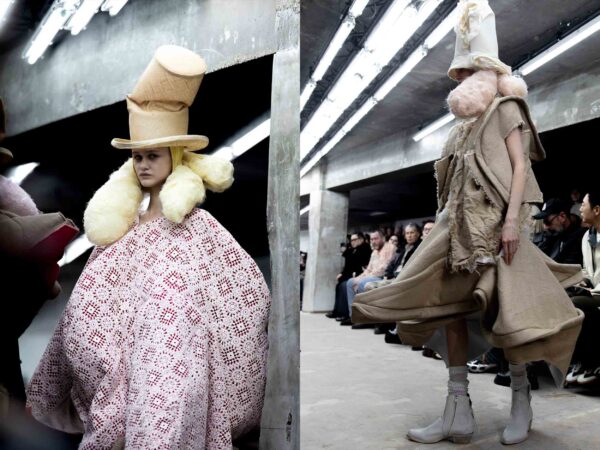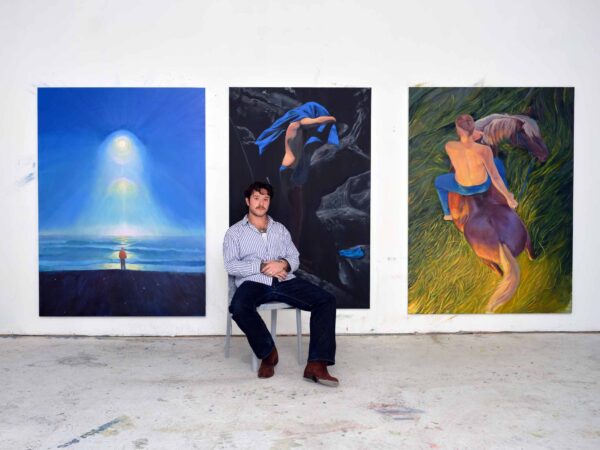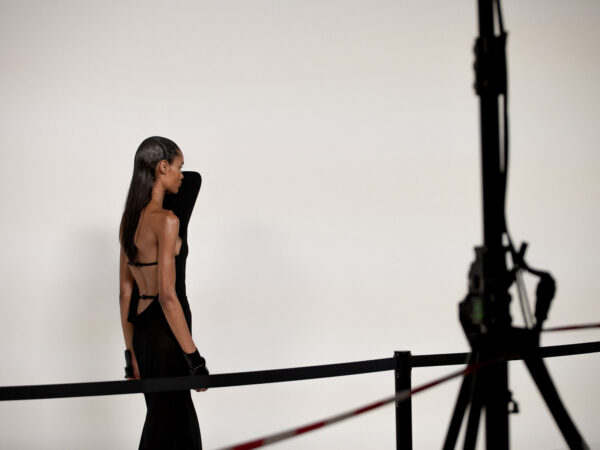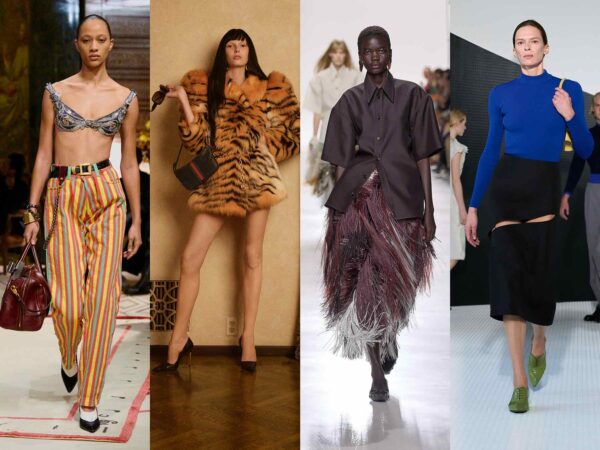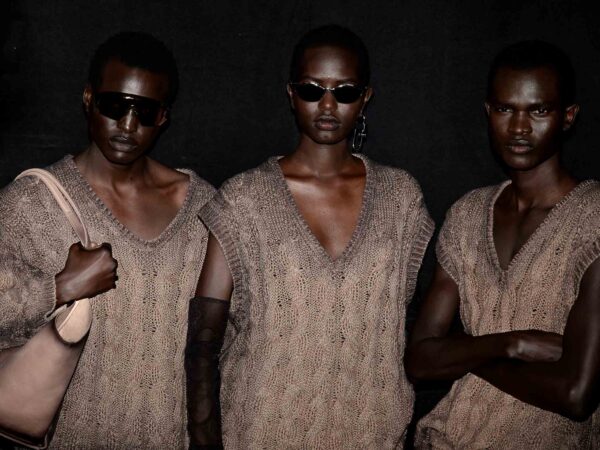
Hair, plastic, clay, and pictures come together to challenge conceptions of illness and image at the artist and poet’s photography installation at A.I.R. Gallery
The photo is black and white, the figure bright behind a glass door’s grille. We cannot see the face. In another nearby photo a figure dressed in white stands by a tree, ghostly, limbs amiss, at once stockstill and blurred by motion.
Low-pile brown carpet blankets the floor. Semi-transparent plastic tarps contort atop it, laden with red dirt and unfired ceramic trays. Up close, you discover sculpted bugs and brass pins punctuate the trays. Most photos hang eye level except one, of the artist’s mother, which you must bow to see.
In this my whole hole whole hole this still little me me me—an exhibition at A.I.R. Gallery by the New York-based artist Funto Omojola—bodies and their remnants are at once hyper-present and at a remove. Hair is placed behind glass, so abundant that it becomes nearly abstract. A lone leg dangles from a banister, floating as if freed from any being.
Working with writing, photography, sculpture, and sound, Omojola’s multimedia practice bridges tools of testimony with experiences that exceed the knowledge systems of monolithic worldviews. In their widely published and performed poetry, Omojola merges multiple languages and traces intergenerational linkages unfurling across Nigeria, Europe, and the US. Though featuring none of their own words (their mother and father, however, each wrote a poem for the press release), this my whole hole whole hole this still little me me me forms a kind of diptych with their forthcoming full-length poetry debut, If I Gather Here and Shout. In both projects, narratives—personal, folkloric, and medical—glimmer between clarity and obscurity, the mystic and the insistently material.
Omojola’s installation at A.I.R.—following their fellowship at the 52-year-old organization—cuts, displaces, displays, and hides. Confronting the effects of medicalization and colonialism, these performance-images and sculptures shift Western epistemologies from center to edge. Their metaphoric incisions don’t leave lacunae, but graft in ancestral connectivities and Yoruba cosmologies. The crystalline facets of writing and photography—those tools’ alleged truths—refract something unknown.
Drew Zeiba: What’s the central anchor for this my whole hole whole hole this still little me me me?
Funto Omojola: I’m usually thinking of different knowledge systems, particularly as they relate to illness, and in my writing, I’m writing a lot from the Yoruba knowledge system. I’m claiming that as center, even though it’s often at the edges in terms of the audience reading my work. I was thinking about what it meant to language illness in this peripheral knowledge system but through image-making. What does it mean to take an image of a Black African body? And not with the prototypical Western understanding of what the image of the Black body means. I started thinking about ideas of illness in Yoruba cosmology—like when you’re sick, it’s because there’s a pot that bubbles over. It’s this really moral thing. You need to add in the correct ingredients and materials or go to the babaláwo to change your fate or fix your fate. That’s where the central images of me as this ill body moving through the interior and exterior spaces come from. And thinking through how to language that illness on my body—and the stain of illness on a lineage. But I was also thinking about what happens when the viewer is looking at the image or synthesizing these images from Western knowledge systems.
Drew: I’m curious about the role of obscurity in the show, and maybe we can talk about that more generally. But specifically, I’m also curious about this plastic material on the floor, which also wraps a couple of the photo-works. Around the photos it almost feels protective, as if you’re going to be moving them, but on the floor they’re crumpled and filled with dirt. What are you doing with this material?
Funto: It’s what you’re saying: covering and protection—but also remains. What remains. I’ve been collecting my hair for many years. And in Yoruba culture, you burn your hair, you don’t collect it, you don’t even flush it because someone can take it and kill you with it or put a spell on you. One of my favorite pieces is What Will Become of Me by Adrian Piper, and I’m thinking of this collection of debris and body and hair and nails in the sense of what happens to that in the institution, but also what happens when a body has been looted or land has been looted and what remains. How do you make images of those remains in a way that doesn’t feel like you’re aestheticizing loss and death? There have been so many iterations of this image where there’s body and tarp and body and something that a remain is wrapped in.
I’ve been making these clay sculptures of divination trays. Often they were stolen from Nigeria during the transatlantic slave trade and a lot of them are in museums as artworks, but they’re actually tools that if you go to homes you find on the ground. Someone could use them at any minute to divine or show your fortune. So thinking through remains in that sense, in terms of looting of land, but also looting of the body. I was really, really fascinated with this tarp that is so fragile and see-through but also can hold so much. And also can reveal as much as you want it to in terms of how it’s folded over itself or how it covers itself.
Drew: It’s interesting because both pieces titled Àláfíà look like they could be holding multiple portraits of family members, like someone would hang at home. But up close, through the tarp, you realize that in the smaller matted cutaways, the head is being covered by a hand. The large photo in Àláfíà on the right looks to me like a hole in the ground. The blurriness of the tarp over the images makes you want to come close, but then even once you get there, your ability to read the subjects of the images is thwarted.
Funto: I took a trip to Nigeria, where these images were made. It was the first time I’d been back since I immigrated to this country. And I felt really disoriented. I found myself thinking, I want to go home. And it was this moment where I was like, Oh, the work I make is in relation to my idea of Nigeria being my home and my being a displaced body. And then something strange happened when I was in this place. I felt so dislocated, and I ended up taking a lot of photos of the ground with my little digital camera. Maybe it was grounding. That might be too obvious, but when I came back it was a way to track how I felt or where I was going. I was really interested in the obfuscation of what it meant for my body to not feel at home in this place that is so central to my idea of these knowledge systems that I’m making art from or writing from.
Drew: And these figures—they’re also photos you took in Nigeria?
Funto: These are all photos that I took also of my family members, some of whom I had never met or I was seeing for the first time in a long time. It also felt weird to take their photographs and to use them. I mean, when I take photographs of my sister or my mom or my aunt, they’re consenting to it and they understand what I’m trying to say. There’s a story that’s being told. But these are just photographs that were taken in the moment or candidly. And so I was thinking through how those could be further warped or hidden or layered over to protect their bodies to protect the ground.
Drew: Is this dirt on the floor?
Funto: That’s dirt, some of which I brought back from Nigeria. There’s that really recognizable red dirt in parts of Nigeria. It was everywhere, but also felt really foreign. The redness of the land felt interesting and strange. And again, there’s some of my bodily debris in the dirt in there.
“These are two modes of languaging that illness, but they’re at different times in the process of the illness. But both are disrupting prototypical systems of understanding illness and death in the body.”
Drew: This has me thinking of a lot of early bio art, where people have done projects around surgeries, and how what is excised no longer is yours—it’s often even illegal for you to have. In your show, there’s so much excision and removal and displacement. I’m wondering about the tie to being an ill body and how that manifests not only in your thinking through the Youruba cosmology, but also some of the formal choices in the images and how they’re put together.
Funto: I was thinking a lot about what it means to function again after a medical procedure, whether intense or more benign. Also, it’s this thing where visibly, I’m able-bodied, but I deal with a lot of chronic pain that isn’t seen. And after the hospital, I had to learn how to eat, how to work with my stomach again, or understand how my stomach processes or digests food. This [body no be firewood ii] is a long exposure at night, so I was moving, but also I was still at points, so my head didn’t show up, one of my legs didn’t show up. I tried to process the feeling of disorientation in an ill body coming out of that medical procedure through the process of image-making itself. And also using a four-by-five camera, it’s a very, very slow process. You take a bunch of shots, and you don’t see what they look like. You could go months without seeing them. It’s really expensive so sometimes I just don’t develop my things for a while. And even that, I feel, is a process of working through healing or discovering what the body has become after this process of taking a photograph that isn’t immediate—isn’t as immediate as writing is, for example. So in a lot of these I’m moving, but I’m also still at moments. They’re long exposures or double exposures. So naturally, parts of my body disappear, or different parts come into focus.
Drew: Do you think of these as self-portraits? Or are they performance documentations? I guess I’m asking how much it matters or in which ways it does or doesn’t matter that they’re depictions of you?
Funto: I’m not sure that I would call them self-portraits. I’m curious what they would look like if they weren’t my body, and I was directing a different body. I think, naturally, it’s easier to use my own body. But I think of them as stills of a moving thing. So those pieces [body no be firewood vi and body no be firewood vii] are good examples. Like, there was a third and fourth and a fifth one, where I was just moving or moving around the bed, and I had the camera over me. Thinking of them as a still or moment in a performance of my body feels more authentic to what I’m doing. I never go in thinking of one image that I want. That process happens after the fact.
Drew: So much of your practice is writing. Where does language fit in or split off from these photos and sculptures? What’s the conjunction? How does your writing practice, or writing as such, or languaging, relate to these?
Funto: I think they’re two different modes of languaging. I think when I was in the hospital, I had my journal and I could write and it felt immediate to how I was feeling. If I felt pain in a certain part of my body, I could locate it and name it immediately on the page. And this [exhibition] felt more like a process of grieving or healing. These are two modes of languaging that illness, but they’re at different times in the process of the illness. But both are disrupting prototypical systems of understanding illness and death in the body. They meet where I’m actively trying to make the image in a way that’s outside of that knowledge system in the same way that I’m trying to write outside of those knowledge systems.
Drew: Are you gonna use photos in your book [If I Gather Here and Shout, forthcoming fall 2024]?
Funto: I’m not, actually. There’s only one photo in my book. Because I think that language did the work. I think they diluted each other. When you have two mediums working side by side, they have to do different work. And I think the images were doing the same thing that the poems were. So it makes sense that the work can split off and be its own thing that’s still holding the essence of what I’m trying to say in the writing. But I think they can exist differently. I trust that the writing is doing the work.
Drew: But the title of the show is from a poem, right?
Funto: The title is from a poem in my book, which was one of the first poems I wrote in that body of work, working through the frustration of your body just not operating the way that you would like it to and kind of [asking] what to do with what’s left. That felt apt for talking about this work.
Drew: The Àláfíà pieces are digital and color, but the rest are analog black and white. Why black and white?
Funto: There’s a certain placelessness and timelessness that feels right with black and white. I know that sounds a little bit fucked up, but there’s a nonlinearity that I feel with black and white that I don’t feel with color. And also that ghostly presence of something remaining feels really central and legible.
Drew: What do you mean by nonlinear? As in, how unlike color, black and white doesn’t feel as much like ‘real life’?
Funto: Yeah, I think so. That’s what it is for me. That’s also how I write. There’s no beginning and there’s no end in mind. I feel that same way with black and white.
Drew: Except for a couple they look as if they’re shot at night, and so the black and white produces so much recession. You look and you think it’s almost been resolved, or it’s the darkest shadow, but then there’s something that goes deeper still.
Funto: In the same way with this hair piece [what will become of me, hair and skin behind a 20-by-16-inch glass frame], where it’s this three-dimensional object flattened, I edit my images really gray. Obviously there’s a lot of contrast with black and white, but I flatten them a bit. The object here, or the body, becomes flat. That feels like what I’m trying to do with the images themselves—to make them, as much as I can, two-dimensional.





